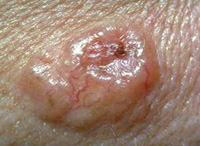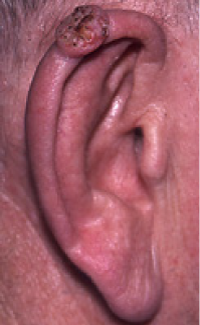Non-Melanoma Skin Cancer
In the UK, around 147,000 new cases of non-melanoma skin cancer are diagnosed each year. It affects more men than women and is more common in the elderly. Non-melanoma skin cancer most often develops on areas of skin regularly exposed to the sun, such as the face, ears, hands, shoulders, upper chest and back.
Please be in touch - either by sending in a photograph or booking a face to face appointment to see a GP if you have any skin abnormality, such as a lump, ulcer, lesion or skin discolouration that has not healed after 4 weeks. While it's unlikely to be skin cancer, it's best to get it checked.
Types of non-melanoma skin cancer
Non-melanoma skin cancers usually develop in the outermost layer of skin (epidermis) and are often named after the type of skin cell from which they develop.
The 2 most common types of non-melanoma skin cancer are:
- basal cell carcinoma (BCC), also known as a rodent ulcer, starts in the cells lining the bottom of the epidermis and accounts for about 75 in every 100 skin cancers
- squamous cell carcinoma (SCC) starts in the cells lining the top of the epidermis and accounts for about 20 in every 100 skin cancers
Basal cell carcinoma
Basal cell carcinoma (BCC) usually appears as a small, shiny pink or pearly-white lump with a translucent or waxy appearance. It can also look like a red, scaly patch.
There's sometimes some brown or black pigment within the patch.
The lump slowly gets bigger and may become crusty, bleed or develop into a painless ulcer.

Image courtesy of the primary care dermatology society
In most cases, cancerous lumps are red and firm and sometimes turn into ulcers, while cancerous patches are usually flat and scaly.
Basal cell carcinoma does not usually spread to other parts of the body. There's a small risk (up to 5%) of squamous cell carcinoma spreading to other parts of the body, usually the lymph nodes (small glands found throughout your body).
Squamous cell carcinoma

Image courtesy of cancerresearchuk
Squamous cell carcinoma (SCC) appears as a firm pink lump with a rough or crusted surface. There can be a lot of surface scale and sometimes even a spiky horn sticking up from the surface.
The lump often feels tender when touched, bleeds easily and may develop into an ulcer.
For both SCC and BCC there can sometimes be considerable skin damage if the tumour is not treated.
Bowen's disease
Bowen's disease is a precancerous form of Squamous cell carcinoma SCC sometimes referred to as squamous cell carcinoma in situ. It develops slowly and is easily treated.
The main sign is a red, scaly patch on the skin that may itch. It most commonly affects elderly women and is often found on the lower leg. However, it can appear on any area of skin.
Although not classed as non-melanoma skin cancer, Bowen's disease can sometimes develop into SCC if left untreated.
Actinic keratoses
Actinic keratoses, also known as solar keratoses, are dry, scaly patches of skin caused by damage from years of sun exposure.
The patches can be pink, red or brown, and can vary in size from a few millimetres to a few centimetres across.
The affected skin can sometimes become very thick, and occasionally the patches can look like small horns or spikes.
Like Bowen's disease, actinic keratosis is not classed as non-melanoma skin cancer, but there's a small risk that the patches could develop into squamous cell carcinoma (SCC) if untreated.
What causes non-melanoma skin cancer?
Overexposure to ultraviolet (UV) light is the main cause of non-melanoma skin cancer. UV light comes from the sun, as well as from artificial tanning sunbeds and sunlamps.
Other risk factors that can increase your chances of developing non-melanoma skin cancer include:
- a previous non-melanoma skin cancer
- a family history of skin cancer
- pale skin that burns easily
- a large number of moles or freckles
- taking medicine that suppresses your immune system
- a co-existing medical condition that suppresses your immune system
Diagnosing non-melanoma skin cancer
We can examine your skin for signs of skin cancer.
We can treat most Basal cell skin cancers, actinic keratoses and Bowen's Disease in the our skin cancer clinic. Other more extensive basal cell carcinomas will require a non urgent referral to be seen in hospital outpatients at the Royal Devon and Exeter Hospital.
Most Squamous Cell Carcinomas are referred urgently for assessment or surgery at the Royal Devon and Exeter Hospital.
Treating non-melanoma skin cancer
Surgery is the main treatment for non-melanoma skin cancer. It involves removing the cancerous tumour and some of the surrounding skin.
Other treatments for non-melanoma skin cancer include freezing (cryotherapy), anti-cancer creams, radiotherapy and a form of light treatment called photodynamic therapy (PDT).
The treatment used will depend on the type, size and location of the non-melanoma skin cancer you have.
Treatment for non-melanoma skin cancer is usually successful as, unlike most other types of cancer, there's a considerably lower risk that the cancer will spread to other parts of the body.
Basal cell carcinoma (BCC) does not usually spread to other parts of the body. There's a small risk (up to 5%) of squamous cell carcinoma (SCC) spreading to other parts of the body, usually the lymph nodes (small glands found throughout your body).
However, for both BCC and SCC there can sometimes be considerable skin damage if the tumour is not treated.
At least 9 out of 10 non-melanoma skin cancer cases are successfully cured.
Complications
If you've had non-melanoma skin cancer in the past, there's a chance the condition may return.
The chance of non-melanoma skin cancer returning is increased if your previous cancer was large in size and high grade (severe).
If your cancer team feels there's a significant risk of non-melanoma skin cancer returning, you'll probably need regular check-ups to monitor your health.
It's also important to be aware that if you've had a non-melanoma skin cancer, your risk of developing another one in the future is increased because these cancers are often multiple.
This means it's important to regularly examine your skin to check for new tumours.
Preventing non-melanoma skin cancer
Non-melanoma skin cancer is not always preventable, but you can reduce your chance of developing it by avoiding overexposure to UV light.
You can protect yourself from sunburn by using high-factor sunscreen, dressing sensibly in the sun, and limiting the amount of time you spend in the sun during the hottest part of the day.
Sunbeds and sunlamps should also be avoided.
Regularly checking your skin for signs of skin cancer can help lead to an early diagnosis and increase your chance of successful treatment.
We use cookies to help provide you with the best possible online experience.
By using this site, you agree that we may store and access cookies on your device. Cookie policy.
Cookie settings.
Functional Cookies
Functional Cookies are enabled by default at all times so that we can save your preferences for cookie settings and ensure site works and delivers best experience.
3rd Party Cookies
This website uses Google Analytics to collect anonymous information such as the number of visitors to the site, and the most popular pages.
Keeping this cookie enabled helps us to improve our website.

